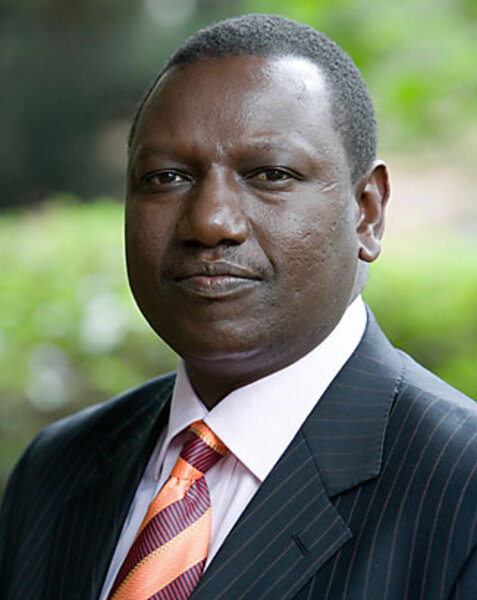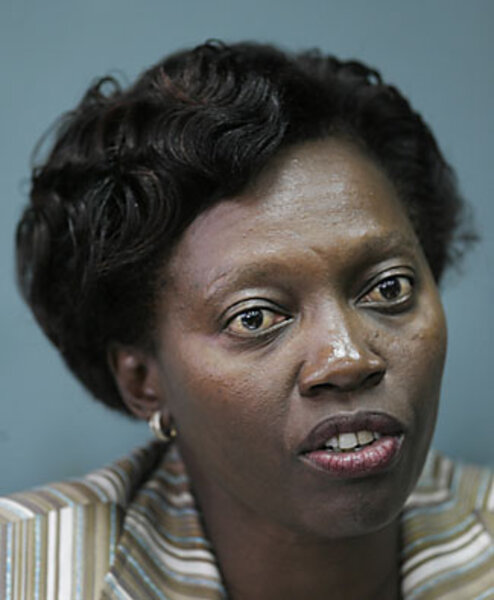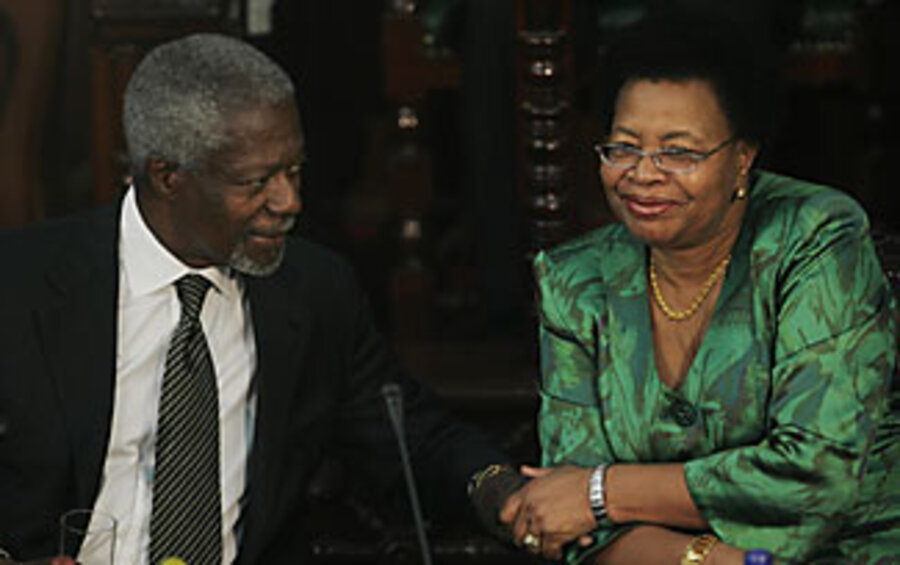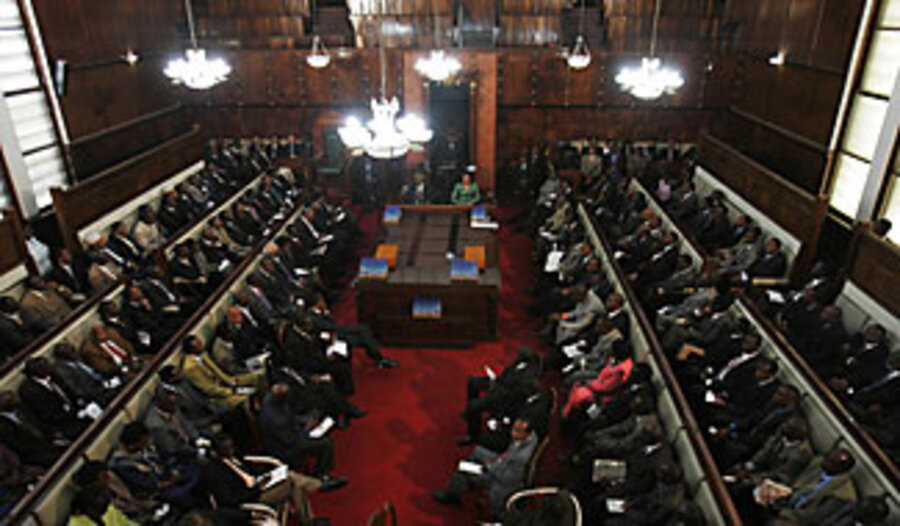In Kenya, two protagonists and the conciliators
| Nairobi, Kenya
William Ruto might seem an odd choice as a peace negotiator. He has the burly frame of a boxer, and a political reputation to match.
In the weeks before he sat down at Kenya's peace table, he was known for his impassioned campaign speeches in his home district in the Rift Valley. Mr. Ruto's critics, including Human Rights Watch, accuse him of igniting ethnic violence in the region where some of the worst fighting occurred.
His campaign slogan was "majimbo!" It's a Swahili term that his Orange Democratic Movement (ODM) party interprets as merely "regionalism" – a devolution of power to the states or provinces.
"The majimbo wave is here and it is unstoppable," Ruto told a jubilant crowd in the town of Kiserian on Oct. 17, 2007. "It is the only way to ensure equitable distribution of resources."
But for many of Ruto's supporters, majimbo has an ominous connotation: giving control of key regions to tribal majorities. In the Rift Valley, that meant giving Ruto's own Kalenjins the right to make all local decisions, and expel ethnic minorities back to their own "jimbos" or homelands.
Today, Ruto says the violence after the Dec. 27 election was "spontaneous." The trouble, he says, was sparked by persistent irregularities, accusations of vote-tampering, and the swift swearing in of President Kibaki by his handpicked electoral commissioner just two days after the election.
"All that acrimony and pull and push was happening on TV cameras, and the whole country was engaged in that process," recalls Ruto, now ensconced in his offices as minister of agriculture. "As to who won the elections, all sides believed that they did, and therefore it was not possible for one candidate [President Kibaki] to announce that he won."
Organized or spontaneous, Ruto's ODM party supporters in the Rift Valley went on a deadly rampage, hunting down Kikuyus and others for their assumed support of President Kibaki. The death toll rose rapidly from 270 in the first week to at least 650 by Jan. 22. By mid-January, UNICEF estimated that 255,000 Kenyans had been displaced, 100,000 of them children.
• • •
Holed up in the State House and watching the mayhem unleashed, President Mwai Kibaki had his own hard-liner: Martha Karua. Mrs. Karua built her reputation as a trial lawyer and crusader for women's rights in Kenya. She is tough, methodical, and unyielding. She is only the third woman ever elected to Kenya's parliament.
During the 2007 election campaign and the violence that followed, Karua emerged as the leading voice of President Kibaki's supporters. She accused the ODM, the party of opposition presidential candidate Raila Odinga, of "ethnic cleansing" in the aftermath of the elections.
Someone, she says today, had "to stand up to the perpetrators of the violence, violence had been legitimized as a means to power.... The violence was clearly premeditated. But the international community didn't want to hear of it."
During the bloody early days of January, it was antagonistic hard-liners like Ruto and Karua who drove these two political movements into almost daily confrontation, and nearly pulled their country apart.
By mid-January, Kenya's economy was losing $80 million a day as businesses shuttered and tourists deserted the beaches and safari lodges. Neighboring countries such as Uganda, Rwanda, southern Sudan, and Congo found their supplies of gasoline – trucked in from Kenya's seaports – suddenly cut off.
While the two presidential antagonists waited for each other to back down, the violence continued. But in the violence were the seeds of its own destruction, as it created an urgency for international intervention.
"The intensity of the violence was so forceful in my opinion, and so unexpected, that it made people think twice, it made people want to stop it," says Wangari Maathai, the Nobel Prize-winning Kenyan environmental activist.
• • •
At the negotiating table at the Serena Hotel, Ruto and Karua fulfill their roles as champions of their respective parties: Ruto the emotional shouter, Karua the poker-faced attorney. But another personality type emerges as well: the conciliators.
On the president's side, Mutula Kilonzo is the team's problem solver.
While other members dig in their heels for the maximum gain, Mr. Kilonzo is scribbling notes, treating the negotiations as a puzzle to be solved. A sign in his downtown legal office describes his approach: "If you can't go over it, around it, or through it, you'll have to negotiate with it."
On ODM's side, the conciliator is James Orengo, an attorney and "young Turk" who in the 1990s helped form the first real political movement to threaten President Daniel arap Moi.
The two men's willingness to discuss compromises causes some tension among their fellow teammates. More than once, team leader Karua reins in Kilonzo on a possible power-sharing deal with her tart refrain, "President Kibaki is the duly elected president. If the opposition wants to join his government, they must first accept that he is the duly elected president."
Kilonzo recalls that "there were times when the anger was clear on the table, there was hostility, name-calling. During situations when you find almost hostility between the two groups, I ended up intervening, because I don't take things personally."
The conciliators kept the talks from derailing completely, but progress remained slow. And in between sessions, Kilonzo's teammates would accost him: "Mutula, you are selling us [out]."
• • •
For Kofi Annan, the chief mediator, these talks are never leisurely. Like his first foray into international mediation – in 1998, he flew to Baghdad as UN secretary-general in a failed attempt to get Saddam Hussein to comply with UN weapons inspections – his mediations in Kenya are a "race against time."
At the Kenya talks, Mr. Annan allows both sides to debate a point, but not endlessly. By Week 2, his habit of cutting off debate and moving on to the next subject is starting to get on Karua's nerves. She complains that the pace is leaving her "breathless."
"At times, they felt I was pushing them too hard," Annan admits. "But the issues are ... extremely important and we need to find a solution as quickly as we can."
But in contrast to Karua, the ODM team wants the talks to go faster. "For us, it was going too slow," Mr. Orengo says. "You walked out on the street ... and you could feel the anxiety and the tension.... The country was saying, 'Without the Annan process, there is no solution.'"
But after two weeks, both sides are still fighting over key issues. And Annan makes a public disclosure that threatens to derail the talks.
This is the third installment of the four-part series "How peace came to Kenya."
Part 1: Africa's elders seize a leading role
Part 2: A month of attacks, then quiet progress








